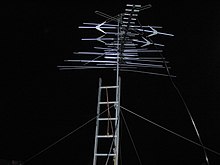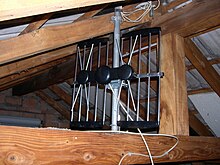



UHF television broadcasting is the use of ultra high frequency (UHF) radio for over-the-air transmission of television signals. UHF frequencies are used for both analog and digital television broadcasts. UHF channels are typically given higher channel numbers, like the US arrangement with VHF channels (initially) 1 to 13, and UHF channels (initially) numbered 14 to 83. Compared with an equivalent VHF television transmitter, to cover the same geographic area with a UHF transmitter requires a higher effective radiated power, implying a more powerful transmitter or a more complex antenna.[citation needed] However, the additional channels allow more broadcasters in a given region without causing objectionable mutual interference.
UHF broadcasting became possible due to the introduction of new high-frequency vacuum tubes developed by Philips immediately prior to the opening of World War II. These were used in experimental television receivers in the UK in the 1930s, and became widely used during the war as radar receivers. Surplus tubes flooded the market in the post-war era. At the same time, the development of color television was taking its first steps, initially based on incompatible transmission systems. The US FCC set aside a block of the then-unused and now-practical UHF frequencies for color television use. The introduction of the backward compatible NTSC standard led to these channels being released for any television use in 1952.
Early receivers were generally less efficient at UHF band reception, and the signals are also subject to more environmental interference.[1] Additionally, the signals are less susceptible to diffraction effects, which can improve reception at long range.[2] UHF generally had less clear signals, and for some markets, became the home of smaller broadcasters who were not willing to bid on the more coveted VHF allocations. These issues are greatly reduced with digital television, and today most over-the-air broadcasts take place on UHF, while VHF channels are being retired. To avoid giving the impression that channels were disappearing, digital broadcast systems have a virtual channel concept, allowing stations to display their original VHF channel number while actually broadcasting on a UHF frequency.
Over time a number of former television channels in the upper UHF band have been re-designated for other uses. Channel 37 was never used in the US and some other countries in order to prevent interference with radio astronomy. In 1983, the US FCC reassigned channels 70 through 83 to the Land Mobile Radio System. In 2009, with the move to digital television complete in the US, channels 52 through 69 were reallocated as the 700 MHz band for cellular telephone service. In 2011, Channel 51 was removed to prevent interference with the 700 MHz cellular band. Additionally, in 2019 the US removed channels 38 through 50 to use them for cellular phone service. Thus UHF TV in the US now only includes channels 14 through 36.
- ^ "A Guide to UHF Television Reception". University of Indiana.
- ^ "Choosing a mounting site". HDTVPrimer.